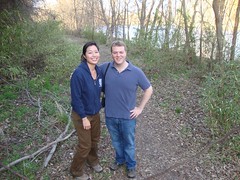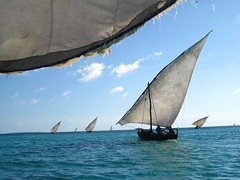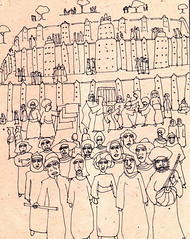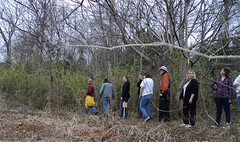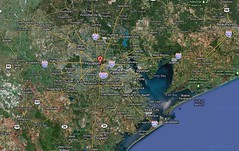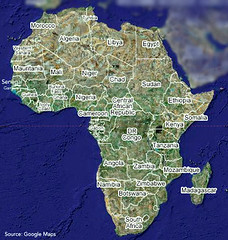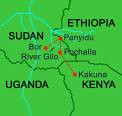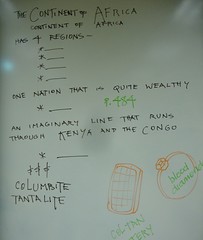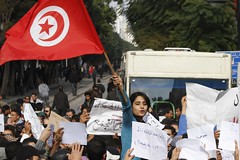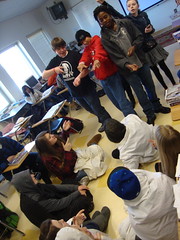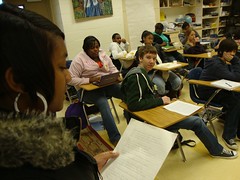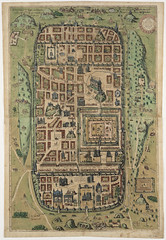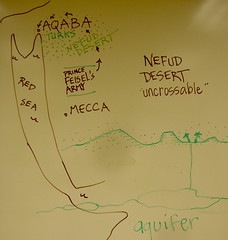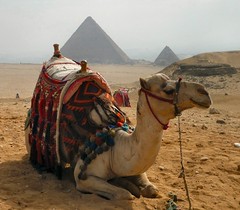A draft of the check-off sheet to be carried by each student on the Coates Bluff nature walk:
Coates Bluff / riparian flora and fauna (riparian refers to the bank of a stream)
__Sycamore: tall tree; peeling bark and large leaves.
__ Cottonwood: one of the largest N Amer hardwood trees. Riverine (usually grows in river bottoms).
__ Water oak: fast-growing, tall bottomland oak that is very important to wildlife.
__ Willow: medicinal bark, extensive root system, used in wood products industry.
__ Hackberry: medium-sized tree important to the lumber industry and to wildlife. The bark is studded with warts.
__ Dogwood: though a small tree, its leaves (ink, dyes) and wood (mallets, tool handles) have long been useful in small industry.
__ Box elder (a type of maple): medium-sized tree of the bottom land.
__ Virginia creeper: a ground cover that inhibits erosion. Medicinal plant - but the berries are poisonous. Similar to poison ivy but has 5 leaflets instead of 3.
__ Muscadine vine: wine or jam is made from tart muscadine grapes. Anti-cancer properties in the grapes.
__ Poison ivy: a noxious weed of which it is said, "Leaves of three, let it be," "Longer middle stem, stay away from them," and "Hairy vine, no friend of mine." It can grow as a shrub or a vine.
Upland growth
__ Hickory: important source of wildlife food; wood is useful in numerous industries (from lumber to smoked meat).
__ Live oak: an evergreen known for its long life and spreading branches; important to wildlife for its acorns and known for strength of its wood.
__ Pine: commercially important for timber and wood pulp. They are fast-growing softwoods that live in the uplands.
Fauna
__ Armadillos: burrowing mammals with a leathery shell that eat insects. Important to scientists.
__ Hawks or falcons: swift birds of prey.
__ Black snake: non-poisonous and hibernating in the winter. They eat rodents, eggs and other snakes.
Smells
__ Loamy (loam is soil composed of clay, silt and sand.) and sandy soil. Decomposing leaves.
Sounds
__ Crows. Hawks. Mockingbirds. Sparrows.
__ Critters escaping though the leaves.
Non-woodsy materials
__ Litter.
__ Fencing, gravestones, etc.
Monday, February 28, 2011
Thursday, February 24, 2011
African island video, "Leopards of Zanzibar" / Zanzibar Island - Tanzania
National Geographic, "Leopards of Zanzibar"
Swahili culture:
Somalia to Mozambique along the Indian Ocean. A cross-roads for men from China, Persia, Arbia. This is a region of ancient trading routes: men grew wealthy handling spices, ivory, slaves.
Swahili is a blend of Arabic, European and tribal words, Kiswahili is both a language and a name for the blended culture.
The people traditionally fish along the coral reef which surrounds their coastline. They cut the coral to make houses out of the stony material.
Coral is a slow-growing organism but this coast is historically rich in coral polyps.
Today the women are harvesting seaweed in the shallows. Cosmetics, toothpaste and beer are among the products that include elements made from this seaweed.
The principal character, Issa, makes his living as a free diver. He spends some 7 hrs a day in the water. He can dive as deep as 50 feet and stay under 3 mins at a time. His principal commodity is the edible octopus.
In this video Issa faces several challenges. One is how to bring his soccer team (soccer was introduced by the English in the mid 1800's) to the playoffs on the mainland. The second is how to make the money to pay the team's expenses.
His breakthrough concerns a fishing stratagem. He moves from spearing octopus to luring lobster.
Map -
- Tanzania
- Dar es Salaam
- Kenya
- Nairobi
- Indian Ocean
- palm trees
- dhows
Swahili culture:
Somalia to Mozambique along the Indian Ocean. A cross-roads for men from China, Persia, Arbia. This is a region of ancient trading routes: men grew wealthy handling spices, ivory, slaves.
Swahili is a blend of Arabic, European and tribal words, Kiswahili is both a language and a name for the blended culture.
The people traditionally fish along the coral reef which surrounds their coastline. They cut the coral to make houses out of the stony material.
Coral is a slow-growing organism but this coast is historically rich in coral polyps.
Today the women are harvesting seaweed in the shallows. Cosmetics, toothpaste and beer are among the products that include elements made from this seaweed.
The principal character, Issa, makes his living as a free diver. He spends some 7 hrs a day in the water. He can dive as deep as 50 feet and stay under 3 mins at a time. His principal commodity is the edible octopus.
In this video Issa faces several challenges. One is how to bring his soccer team (soccer was introduced by the English in the mid 1800's) to the playoffs on the mainland. The second is how to make the money to pay the team's expenses.
His breakthrough concerns a fishing stratagem. He moves from spearing octopus to luring lobster.
Map -
- Tanzania
- Dar es Salaam
- Kenya
- Nairobi
- Indian Ocean
- palm trees
- dhows
The Boy and the Crocodile, a West African fable from Alex Haley's historic book, Roots: the Saga of an American Family
In chapter four of Alex Haley's Roots: The Saga of an American Family, there is a fable called the Boy and the Crocodile.
The theme, one perhaps not typical of Western literature, is "Oftentimes, goodness is repaid with badness."
The storyteller is an old woman, Nyo Boto.
The story includes an elderly donkey and horse, a plump rabbit and swift dog in addition to the crocodile, which has been caught in a net in the river. The tale takes place in the West African nation of Guinea.
Please take notes on and learn this tale so that you can be quizzed on it.
The theme, one perhaps not typical of Western literature, is "Oftentimes, goodness is repaid with badness."
The storyteller is an old woman, Nyo Boto.
The story includes an elderly donkey and horse, a plump rabbit and swift dog in addition to the crocodile, which has been caught in a net in the river. The tale takes place in the West African nation of Guinea.
Please take notes on and learn this tale so that you can be quizzed on it.
Tuesday, February 22, 2011
Need parent volunteers to chaperone a Coates Bluff Nature Trail hike
Planning a nature hike for geography students - during each of my 4 geography classes - on the Coates Bluff Nature Trail, adjacent to Magnet campus. Tentative dates: Tues, March 1 and Wed, March 2.
Parent chaperones are needed to walk with us.
Since I have walked the trail numerous times I can tell you that the path is well trodden; there is no danger aside from tripping over vines on the leafy trail. We recommend wearing long sleeved garments and pants. Cameras and binoculars are welcome.
Please email me, trudeau11@gmail.com, or meet me at Magnet on my planning period: 10 am - 11:15 am.
The trail begins at the gate in the SE corner of the Magnet / Valencia Park fence - adjacent to the softball field. I plan to have a school bus meet us to take the group back to Magnet.
Parent chaperones are needed to walk with us.
Since I have walked the trail numerous times I can tell you that the path is well trodden; there is no danger aside from tripping over vines on the leafy trail. We recommend wearing long sleeved garments and pants. Cameras and binoculars are welcome.
Please email me, trudeau11@gmail.com, or meet me at Magnet on my planning period: 10 am - 11:15 am.
The trail begins at the gate in the SE corner of the Magnet / Valencia Park fence - adjacent to the softball field. I plan to have a school bus meet us to take the group back to Magnet.
Houston and Kansas City: The Lost Boys of Sudan
"I did not come to the US to get a nice car."
Peter, who wanted to get an American education.
Houston:
- 4th largest US city and sixth-largest metropolitan area in the U.S.
- metro population of approximately 6 million.
- Texas Medical Center—the world's largest concentration of healthcare and research institutions.
- Lyndon B. Johnson Space Center (NASA)
- petroleum
- diversified economy
- Houston Ship Channel connects to Gulf of Mexico.
Kansas City, Missouri (larger) / Kansas City, Kansas
- metro pop. about 2.1 million
- diversified economy
- city of fountains
- jazz and BBQ
- confluence of Kansas River and Missouri River.
Swahili: a universal language of East Africa
Basic Swahili:
Hello - Jambo
Welcome - Karibu
Goodbye - Kwaheri
Yes - Ndiyo
No - Siyo/Hapana
OK - Sawa sawa
Please - Tafadhali
Thank you - Asante
Sorry - Pole
Excuse me - Samahani
No problem - Hakuna matata
What is your name? - Jina lakonani?
My name is ____ - Jina langu ni ___
What's the news? - Habari gani?
Very good - Nzuri sana
Where are the toilets? - Wapi choo?
I don't know - Sijui
I don't understand - Sielewi
Do you speak English? - Una sema KiIngereza?
I speak very little Swahili - Ninasema KiSwahili kidogo sana
Sleep well - Lala salama
Numbers:
zero - sifuri
one - moja
two - mbili
three - tatu
four - nne
five - tano
six - sita
seven - saba
eight - nane
nine - tisa
ten - kumi
Refugees and the continent of Africa
The movie "Lost Boys of Sudan:"
1. Takes place in which of the 4 regions of the continent of Africa? a) North b) East c) West d) Southern.
2. The story begins in which nation? __
3. The story begins near which great river? __
4. Kakuma Refugee Camp is in the nation of __ .
5. The largest city of East Africa on the Indian Ocean: __ .
6. Peter and Santino are relocated to the American city of __ .
7. That city is ranked as the a) fourth b) seventh c) ninth largest - in population - in the US.
8. The body of water that connects the largest Texas city to the Gulf of Mexico: a) Brazos River b) Sabine River c) Galveston Bay.
9. Peter goes to Kansas City in his search for what type of opportunity? __.
1. Takes place in which of the 4 regions of the continent of Africa? a) North b) East c) West d) Southern.
2. The story begins in which nation? __
3. The story begins near which great river? __
4. Kakuma Refugee Camp is in the nation of __ .
5. The largest city of East Africa on the Indian Ocean: __ .
6. Peter and Santino are relocated to the American city of __ .
7. That city is ranked as the a) fourth b) seventh c) ninth largest - in population - in the US.
8. The body of water that connects the largest Texas city to the Gulf of Mexico: a) Brazos River b) Sabine River c) Galveston Bay.
9. Peter goes to Kansas City in his search for what type of opportunity? __.
Monday, February 21, 2011
Friday, February 18, 2011
Magnet geography / Africa: indie work
Independent writing topics include . . .
- Comparing the movies Lawrence of Arabia and The Lost Boys of Sudan.
Please see http://www.lostboysfilm.com/
- Compare the population, industry and politics of Houston and Cairo.
- Blood diamonds and bloody ColTan. A look at the continent of
Africa's most desirable minerals.
- Comparing the movies Lawrence of Arabia and The Lost Boys of Sudan.
Please see http://www.lostboysfilm.com/
- Compare the population, industry and politics of Houston and Cairo.
- Blood diamonds and bloody ColTan. A look at the continent of
Africa's most desirable minerals.
Wednesday, February 16, 2011
K'naan: a Somali singer-songwriter repping East Africa
K'naan grew up in war-torn Mogadishu, Somalia, says NPR.org.
He moved to Toronto at 13 and learned English with the help of Eric B & Rakim records - which helps lend grittiness to his storytelling.
But in "Fatima," performed here, he tells the story of a lost childhood friend with gentle humor and a sober understanding of what our loved ones leave behind.
That song is sandwiched between two magnificent inspirational anthems: "Wavin' Flag" and "Take a Minute," both of which are as uplifting as they are shot through with real-world perspective.
"Take a minute" references Gandhi and Nelson Mandela and the violence his family experienced in Somalia.
K'naan has the makings of a global superstar who's as inspiring as his songs are infectious, believes NPR.
A French-Canadian Media College performed a terrific lip-dub version of the K'naan song, "Wavin' Flag." See it here.
He moved to Toronto at 13 and learned English with the help of Eric B & Rakim records - which helps lend grittiness to his storytelling.
But in "Fatima," performed here, he tells the story of a lost childhood friend with gentle humor and a sober understanding of what our loved ones leave behind.
That song is sandwiched between two magnificent inspirational anthems: "Wavin' Flag" and "Take a Minute," both of which are as uplifting as they are shot through with real-world perspective.
"Take a minute" references Gandhi and Nelson Mandela and the violence his family experienced in Somalia.
K'naan has the makings of a global superstar who's as inspiring as his songs are infectious, believes NPR.
A French-Canadian Media College performed a terrific lip-dub version of the K'naan song, "Wavin' Flag." See it here.
Revolution in 2 African / Mediterranean nations this year: Tunisia and Egypt
In Tunisia and Egypt young demonstrators have taken to the streets in 2011 to protest governmental corruption. The peaceful rallies have been so large and consistent that the presidents of both these nations have resigned.
Why such massive demonstrations? The autocratic, dictatorial governments have been unable to provide jobs for the large population of young and educated citizens. People have realized that these presidents have enriched themselves and their friends in an outrageous way.
That's called governmental corruption.
And poverty has been increasing.
The Tunisian singer Hamada Ben Amor, also known as ''The General,''
has song about corruption called "Rais lebled." This tune has been important to the young protestors in both nations. See it on youtube.com.
Acc to Time magazine, the lyrics include -
"Mr. President, your people are dying / People are eating rubbish / Look at what is happening / Miseries everywhere Mr. President / I talk with no fear / Although I know I will only get troubles / I see injustice everywhere."
Why such massive demonstrations? The autocratic, dictatorial governments have been unable to provide jobs for the large population of young and educated citizens. People have realized that these presidents have enriched themselves and their friends in an outrageous way.
That's called governmental corruption.
And poverty has been increasing.
The Tunisian singer Hamada Ben Amor, also known as ''The General,''
has song about corruption called "Rais lebled." This tune has been important to the young protestors in both nations. See it on youtube.com.
Acc to Time magazine, the lyrics include -
"Mr. President, your people are dying / People are eating rubbish / Look at what is happening / Miseries everywhere Mr. President / I talk with no fear / Although I know I will only get troubles / I see injustice everywhere."
Next quiz: Lawrence of Arabia questions in an open notes test
Please have your notes (see the Lawrence guide on the class blog) on Lawrence of Arabia.
There will be about 15 multiple choice questions.
Questions will focus on
- locations
- nationalities
- cultural factors
- Lawrence's life
There will be about 15 multiple choice questions.
Questions will focus on
- locations
- nationalities
- cultural factors
- Lawrence's life
Writer's Workshop on Thurs after school in E 205
All of my students are encouraged to attend Writer's Workshop after school once a week to get the most out of Magnet.
Held on Thursdays, the session comprises 30 minutes of writing and feedback. It will earn a student immediate points and entails personal instruction in essay writing.
About 3:40 you should report to E205 to discuss a topic with me and begin writing. We will develop your skills and knowledge.
It will be helpful to me if you tell me you're attending the Workshop on a particular Thurs. A note, a word in class or on the hallway, an email will let me know to expect you. Yet telling me that you're attending is not mandatory! Simply show up and with your books and a willing attitude.
Held on Thursdays, the session comprises 30 minutes of writing and feedback. It will earn a student immediate points and entails personal instruction in essay writing.
About 3:40 you should report to E205 to discuss a topic with me and begin writing. We will develop your skills and knowledge.
It will be helpful to me if you tell me you're attending the Workshop on a particular Thurs. A note, a word in class or on the hallway, an email will let me know to expect you. Yet telling me that you're attending is not mandatory! Simply show up and with your books and a willing attitude.
Tuesday, February 15, 2011
Dinka tribal people and "The Lost Boys of Sudan"
The Lost Boys of Sudan movie overview
The Lost Boys of Sudan are more than 27,000 boys of the Dinka ethnic group who were displaced and/or orphaned during the Second Sudanese Civil War (1983-2005, about 2 million killed), says Wikipedia.
The name was given by aid organizations, including the International Rescue Committee program which resettled some of these refugees from Sudan to the United States.
In 2001, about 3800 Lost Boys arrived in the United States, where they are now scattered in about 38 cities.
The Episcopal Church, Catholic Charities and a variety of other charitable organizations helped bring Sudanese refugees to the United States.
A variety of programs have been initiated to help and understand these displaced people, everything from reconnecting families to learning their traditional dancing [3] to dental work to replace teeth which had been removed by traditional custom, but whose loss is negative in the USA [4].
Most of the boys were orphaned or separated from their families when government troops systematically attacked villages in southern Sudan killing many of the inhabitants, most of whom were civilians.[1] The younger boys survived in large numbers because they were away tending herds or were able to escape into the nearby jungles.[1]
Orphaned and with no support, they would make epic journeys lasting years across the borders to international relief camps in Ethiopia and Kenya evading thirst, starvation, wild animals, insects, disease, and one of the most bloody wars of the 20th century.[1]
Experts say they are the most badly war-traumatized children ever examined.[1]
When villages were attacked, girls were raped, killed, taken as slaves to the north, or became servants or adopted children for other Sudanese families. As a result, relatively few girls made it to the refugee camps.
The Lost Boys of Sudan are more than 27,000 boys of the Dinka ethnic group who were displaced and/or orphaned during the Second Sudanese Civil War (1983-2005, about 2 million killed), says Wikipedia.
The name was given by aid organizations, including the International Rescue Committee program which resettled some of these refugees from Sudan to the United States.
In 2001, about 3800 Lost Boys arrived in the United States, where they are now scattered in about 38 cities.
The Episcopal Church, Catholic Charities and a variety of other charitable organizations helped bring Sudanese refugees to the United States.
A variety of programs have been initiated to help and understand these displaced people, everything from reconnecting families to learning their traditional dancing [3] to dental work to replace teeth which had been removed by traditional custom, but whose loss is negative in the USA [4].
Most of the boys were orphaned or separated from their families when government troops systematically attacked villages in southern Sudan killing many of the inhabitants, most of whom were civilians.[1] The younger boys survived in large numbers because they were away tending herds or were able to escape into the nearby jungles.[1]
Orphaned and with no support, they would make epic journeys lasting years across the borders to international relief camps in Ethiopia and Kenya evading thirst, starvation, wild animals, insects, disease, and one of the most bloody wars of the 20th century.[1]
Experts say they are the most badly war-traumatized children ever examined.[1]
When villages were attacked, girls were raped, killed, taken as slaves to the north, or became servants or adopted children for other Sudanese families. As a result, relatively few girls made it to the refugee camps.
The continent of africa, continent of Africa: regions and pertinent nations
The principal nations selected for our unit of study -
East Africa -
Sudan
Ethiopia
Somalia
Kenya
Uganda
Tanzania
Southern Africa -
South Africa (continent's wealthiest nation)
West Africa -
Senegal
Liberia
Cote D'Ivoire
Ghana
Nigeria
Congo
Mediterranean Africa -
Morocco
Egypt
Spain
Israel
Saudi Arabia
Mediterranean
Atlantic
Indian Ocean
Arabian Sea
Red Sea
East Africa -
Sudan
Ethiopia
Somalia
Kenya
Uganda
Tanzania
Southern Africa -
South Africa (continent's wealthiest nation)
West Africa -
Senegal
Liberia
Cote D'Ivoire
Ghana
Nigeria
Congo
Mediterranean Africa -
Morocco
Egypt
Spain
Israel
Saudi Arabia
Mediterranean
Atlantic
Indian Ocean
Arabian Sea
Red Sea
Monday, February 14, 2011
Map quiz on Israel and Jerusalem: Dome of the Rock atop the Temple Mount
Quiz this week comprises 12 items:
2 -4 items from a small sketch of Ancient Jerusalem
8 - 10 items placed on a map of Israel ("Israel is not real.")
You must identify the Mediterranean and must spell it correctly.
Also be ready to answer questions on the basics of Jerusalem:
- "Street of Sorrows:" Via Dolorosa, pathway to the crucifixion.
- Tomb of Jesus of Nazareth's burial and crucufixion: Church of the Holy Sepulchre.
- Sacred to Jews and Muslims: Dome of the Rock atop the Temple Mount. See Abraham and Muhammad the Prophet.
- The ancient Jewish Temple atop the Temple Mount was destroyed by conquerors. All that remains: the Western Wall, or Wailing Wall.
- Pilgrimages
- City of 3 sabbaths: Christians, Sunday, Jews, Saturday (begins Fri at sunset) and Muslims, Friday.
2 -4 items from a small sketch of Ancient Jerusalem
8 - 10 items placed on a map of Israel ("Israel is not real.")
You must identify the Mediterranean and must spell it correctly.
Also be ready to answer questions on the basics of Jerusalem:
- "Street of Sorrows:" Via Dolorosa, pathway to the crucifixion.
- Tomb of Jesus of Nazareth's burial and crucufixion: Church of the Holy Sepulchre.
- Sacred to Jews and Muslims: Dome of the Rock atop the Temple Mount. See Abraham and Muhammad the Prophet.
- The ancient Jewish Temple atop the Temple Mount was destroyed by conquerors. All that remains: the Western Wall, or Wailing Wall.
- Pilgrimages
- City of 3 sabbaths: Christians, Sunday, Jews, Saturday (begins Fri at sunset) and Muslims, Friday.
Monday, February 07, 2011
Map quiz next class; see example here
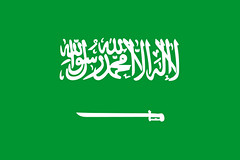
Saudi Arabia / اَلْعَرَبِيَّةُ ٱلسًّعُودِيَّة / Arábia Saudita
Originally uploaded by LisbonVisitor...
Your choices: a) Saudi Arabia b) Israel c) Egypt d) Jordan e)
Syria f) Yemen
g) Iraq h) Lebanon i) Palestine j) Red Sea k) Nile River l) Persian Gulf
m) Arabian Sea n) Indian Ocean o) Atlantic p) Arabian Peninsula q) Cairo
r) Aqaba s) Damascus t) Britain u) France v) the "Med"
1. On his voyage from England to the Mid East, Lawrence had to pass
through 2 bodies of water: the __ and the __ .
2. Lawrence's first post with the British Army was the prominent city of __.
3. In 1914 the British Army sent Lawrence to aid the Bedouin forces
located here: __ .
4. The Med is spelled a) Meditteranean b) Mediterranen c) Meditterranean
d) Mediterranean e) Mediterrenean.
5. Red Sea port held by the Turks during the early part of WWI: __.
6. Between Cairo and Mecca one crosses this body of water: __.
7. Body of water on the eastern side of the Arabian peninsula: __.
8. Nation that lies directly north of Israel on the coast: __.
9. The capture of Damascus is the ultimate goal of the Bedouin forces.
Damascus is the capital of __.
10. On the south coast of the Arabian peninsula is a sea, __, and an ocean, __.
11. Israel's bordering nation on the southwest is __.
12. Mecca is a city in the nation of __.
1. Atlantic, Mediterranean
2. Cairo
3. Arabian Peninsula or Arabia
4. d
5. Aqaba
6. Red Sea
7. Persian Gulf
8. Lebanon
9. Syria
10. Arabian Sea, Indian O
11. Egypt
12. Saudi Arabia
The Jews and the Jewish nation of Israel and the conflict with all the neighboring Arab nations
Notes on Israel and the skit called The Insoluble Problem -
Ancient Palestine, Modern Israel / map items . . .
Jerusalem
Mediterranean
Dead Sea
Jordan River
Sea of Gallilee
Lebanon
Syria
Jordan
Egypt
West Bank region (disputed)
Nazareth
Bethlehem
The Insoluble Problem
Jew vs. Palestinian Muslim Arab
- cousins in blood, language and heritage
- Hebrew & Arabic
- struggle for control of the land of Israel and city of Jerusalem - which has been going on since the Crusades, in the Medieval era.
The Jew vs Palestinian Arab skit:
a) Zionists are Jews who believe that a Jewish homeland in their ancient home of Palestine is important. In the late 1880's and early 1900's they gather funds and purchase land in Palestine.
b) Ottoman Turks owned the land of Palestine. They acquired it when they had a powerful empire. Jews purchase the land cheaply.
c) Palestinian Arabs were mostly shepherds and had overgrazed the land; palestine had become a dry, rocky place early in the 20th century. Jews promises when they got the land they will "Make the deserts bloom." They will use scientific farming to change the terrain.
d) The struggle between those who owned the land by virtue of their long residency and those who purchased it in the modern way is not easily solved. Jews push the Arabs. The Arabs fight back. The Jewish forces ovewhwelm the Arabs.
e) In 1947 the victory of the Jewish forces is complete. They declare a Jewish state to be called Israel.
f) Israel has continually fought to maintain its existence. Its army is called the strongest force in the Mid East. Its principal support - due to lobbying of the US Congress - is foreign aid from the US.
g) The Palestinians have fought back via the intifadeh. That term means a low-cost, terror-based rebellion against the well-equipped Jewish forces. The struggle - which includes suicide bombers - has focused on Gaza and the West bank region.
- Israel's population is not shrinking. They are up from 6 million to 7.3 million. The population comprises some 20% Arab people.
- Israel is a high-tech nation which might go to all-electric vehicles if the Better Place program, founded by Shai Agassi, is successful.
Ancient Palestine, Modern Israel / map items . . .
Jerusalem
Mediterranean
Dead Sea
Jordan River
Sea of Gallilee
Lebanon
Syria
Jordan
Egypt
West Bank region (disputed)
Nazareth
Bethlehem
The Insoluble Problem
Jew vs. Palestinian Muslim Arab
- cousins in blood, language and heritage
- Hebrew & Arabic
- struggle for control of the land of Israel and city of Jerusalem - which has been going on since the Crusades, in the Medieval era.
The Jew vs Palestinian Arab skit:
a) Zionists are Jews who believe that a Jewish homeland in their ancient home of Palestine is important. In the late 1880's and early 1900's they gather funds and purchase land in Palestine.
b) Ottoman Turks owned the land of Palestine. They acquired it when they had a powerful empire. Jews purchase the land cheaply.
c) Palestinian Arabs were mostly shepherds and had overgrazed the land; palestine had become a dry, rocky place early in the 20th century. Jews promises when they got the land they will "Make the deserts bloom." They will use scientific farming to change the terrain.
d) The struggle between those who owned the land by virtue of their long residency and those who purchased it in the modern way is not easily solved. Jews push the Arabs. The Arabs fight back. The Jewish forces ovewhwelm the Arabs.
e) In 1947 the victory of the Jewish forces is complete. They declare a Jewish state to be called Israel.
f) Israel has continually fought to maintain its existence. Its army is called the strongest force in the Mid East. Its principal support - due to lobbying of the US Congress - is foreign aid from the US.
g) The Palestinians have fought back via the intifadeh. That term means a low-cost, terror-based rebellion against the well-equipped Jewish forces. The struggle - which includes suicide bombers - has focused on Gaza and the West bank region.
- Israel's population is not shrinking. They are up from 6 million to 7.3 million. The population comprises some 20% Arab people.
- Israel is a high-tech nation which might go to all-electric vehicles if the Better Place program, founded by Shai Agassi, is successful.
Thursday, February 03, 2011
Dhow fishing nd trading boats: from the coast of India to the coast of Africa
The dhow (Arabic,داو) is a traditional Arab sailing vessel with one or more lateen sails, says Wikipedia.
They are primarily used along the coasts of the Arabian Peninsula, Pakistan, India, and East Africa.
They are primarily used along the coasts of the Arabian Peninsula, Pakistan, India, and East Africa.
Wednesday, February 02, 2011
Lawrence of Arabia and the Bedouins attack the Turks at Aqaba
Arab forces crossed the "uncrosssable" Nefud Desert in following strategy developed by TE Lawrence. They then made a surprise attack on Aqaba. It was a victory for the guerilla style of fighting used by the Bedouins.
With Lawrence as their adviser, the Arab / Bedoiun forces would ultimately attack and win victory at Damascus, Syria, then the capital city of Islam.
Alas, the Bedouins could not cope with the difficulties of managing a large, modern city. The British had to take over the administration of Damascus. The Bedouin victory was thereby compromised.
At the end of WWI, the Arabs demanded independence. They had won their land back from their long-time masters, the Turks. But the victorious British and French took control of the Mid East.
The British drew boundaries and set up the size and shape of the Mid East nations.
The frustrated Arab peoples accepted their fate and made the best of life under the new masters, the Europeans.
With Lawrence as their adviser, the Arab / Bedoiun forces would ultimately attack and win victory at Damascus, Syria, then the capital city of Islam.
Alas, the Bedouins could not cope with the difficulties of managing a large, modern city. The British had to take over the administration of Damascus. The Bedouin victory was thereby compromised.
At the end of WWI, the Arabs demanded independence. They had won their land back from their long-time masters, the Turks. But the victorious British and French took control of the Mid East.
The British drew boundaries and set up the size and shape of the Mid East nations.
The frustrated Arab peoples accepted their fate and made the best of life under the new masters, the Europeans.
Tuesday, February 01, 2011
Mid East map quiz next class!
8 nations:
- Egypt
- Israel / Palestine
- Jordan
- Saudi Arabia
- Yemen
- Iraq
- Lebanon
- Syria
2 continents
1 peninsula
5 bodies of water
- Mediterranean (you must spell it correctly)
- Red Sea
- Persian Gulf
- Arabian Sea
- Indian Ocean
This will be a multiple choice quiz but Without notes! Memorization, just as in a map quiz.
The Lawrence odyssey:
1. Lawrence's home nation: __.
2. L traveled to the Mid East on ship (1914) and went through 2 bodies of water: Atlantic and Med.
3. To a Mid Eastern capital city: __.
4. And another transit via a sea: __ .
5. To a great peninsula: __.
6. To lead an Arab force through an "uncrossable" desert: __.
7. To an attack upon a coastal city held by the Turks: __.
- Egypt
- Israel / Palestine
- Jordan
- Saudi Arabia
- Yemen
- Iraq
- Lebanon
- Syria
2 continents
1 peninsula
5 bodies of water
- Mediterranean (you must spell it correctly)
- Red Sea
- Persian Gulf
- Arabian Sea
- Indian Ocean
This will be a multiple choice quiz but Without notes! Memorization, just as in a map quiz.
The Lawrence odyssey:
1. Lawrence's home nation: __.
2. L traveled to the Mid East on ship (1914) and went through 2 bodies of water: Atlantic and Med.
3. To a Mid Eastern capital city: __.
4. And another transit via a sea: __ .
5. To a great peninsula: __.
6. To lead an Arab force through an "uncrossable" desert: __.
7. To an attack upon a coastal city held by the Turks: __.
Subscribe to:
Comments (Atom)
